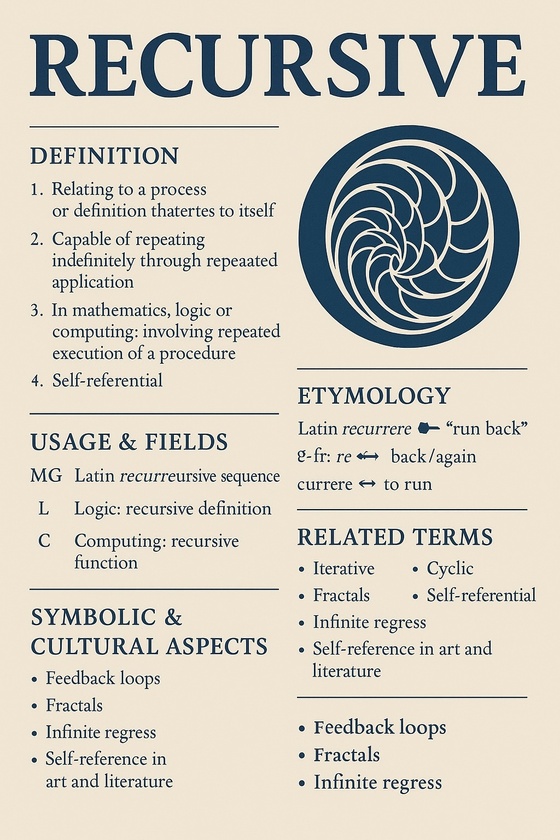Below is a comprehensive, multi-dimensional workup of the word “recursive”, modeled after our prior work on insipid — but tuned to the distinct philosophical, linguistic, computational, and symbolic layers that “recursive” embodies. This entry is suitable for your Codex or formal linguistic repository and is formatted for use as both reference and reflection.
📜 H# Recursive – Full Lexical, Philosophical, and Semiotic Profile
“To loop without loss, to return with refinement.”
Filed in: Language · Symbolic Logic · Computation · Ontology
🔤 Definition
Recursive (adj.)
Mathematics/Logic: Relating to or involving the repeated application of a rule, definition, or procedure to successive results.
Computing: A function or process that calls itself as a subroutine.
Linguistics: A structure that can be embedded within another of the same type (e.g., clauses within clauses).
Philosophy/Systems: Describing a process that refers to or modifies itself, often in a self-reflective or self-generative way.
Metaphorical/Cultural: Pertaining to self-referential systems, feedback loops, or layered structures that reprocess their own outputs.
📚 Etymology
Component | Origin | Meaning |
|---|---|---|
re- | Latin prefix | “again, back” |
currere | Latin verb | “to run” |
→ recurrere | Latin | “to run back,” hence “recur” |
→ recursionem (late Latin) | “a running back, return” | |
→ recursion → recursive | Adopted into logic/math mid-20th c. |
Thus, recursive originally referred to a movement that loops back upon itself — later formalized into symbolic and algorithmic systems.
🧠 Historical and Conceptual Evolution
Period | Domain | Key Concept |
|---|---|---|
Antiquity | Rhetoric / Philosophy | Self-reflection; the hermeneutic circle |
Middle Ages | Theology / Scholastic Logic | God contemplating God; nested causes |
1600s–1800s | Mathematics | Recurrence relations (e.g., Fibonacci) |
1900s | Logic / Computability | Gödel, Turing: recursion in proofs, computability |
Modern | CS, Art, AI, Linguistics | Recursion as structure, engine, aesthetic, or trap |
🧾 Core Properties of Recursive Systems
Self-reference
Base case (stopping rule or ground)
Rule of transformation (what changes with each loop)
Termination or divergence (finite vs infinite recursion)
Emergent complexity (recursive simplicity leads to layered output)
🗣 Linguistic Recursion
In syntax, recursion is the ability to:
Embed a phrase within a phrase of the same type:
e.g., “The cat [that chased the rat [that stole the cheese]] ran.”
This capacity is often cited (e.g. Chomsky) as a hallmark of human language — though contested cross-culturally.
🔁 Common Usage in Technical Fields
Field | Example | Meaning |
|---|---|---|
Mathematics | f(n) = f(n-1) + 1 | Defines itself in terms of previous step |
Computing | recursive function | A function that calls itself |
Philosophy | recursive consciousness | The mind reflecting on its own thoughts |
Systems Theory | recursive feedback | Output reintegrated into input |
Art | Droste effect | Image within itself, infinitely nested |
Design | recursive architecture | Structures built by the repetition of nested forms |
💡 Symbolic & Esoteric Implications
Aspect | Recursive Meaning |
|---|---|
Gnosis | Knowledge that reveals itself only by turning inward repeatedly |
Mysticism | As above, so below as a recursive axiom |
Hermeticism | Recursive symbolism in alchemical stages (solve et coagula) |
AI/Simulation Theory | A system simulating itself → emergence of awareness |
Psychology | Metacognition as recursive cognition |
Sacred Geometry | Fractals as recursion rendered sacred |
🌀 Philosophical Recursion: Self as Function
Recursive systems encode their own interpreter. Consciousness recursively models itself:
“I think that I think that I think…”
Reflexivity → Identity → Paradox
Compare:
Gödel: Self-reference & incompleteness
Douglas Hofstadter: Strange loops
Sanskrit recursive grammar: Panini’s Ashtadhyayi (the world’s first formal grammar system — itself recursive)
🧾 Comparative Terms
Word | Overlap | Key Difference |
|---|---|---|
Repetitive | Surface repetition | Lacks transformation or self-reference |
Cyclic | Circularity | May repeat without internal change |
Fractal | Recursive geometry | Always geometric, often visual |
Nested | Containment | Structural, not always functional |
Self-referential | Mentions itself | Not always functionally recursive |
Iterative | Repeats steps | Procedural, not necessarily self-invoking |
🔂 Recursive vs Iterative (in Computing)
Feature | Recursive | Iterative |
|---|---|---|
Method | Function calls itself | Loop structure (e.g., for, while) |
Memory use | Higher (call stack) | Often lower (in-place) |
Clarity | Often clearer for problems like trees | Better for performance |
Example | Factorial: f(n) = n * f(n-1) | Factorial via loop |
🪞 Recursive in Culture
Film:
Inception – dreams within dreams
Synecdoche, New York – play within a play about the play
Russian Doll – recursive time loops
Literature:
Pale Fire – text referencing itself
House of Leaves – recursive annotations
Mythic:
Ouroboros (snake that eats itself)
Shiva as both dancer and observer of the dance
🏛 Modern Parable Summary (Codex Entry Style)
A recursive thought is the thought that thinks its own source.
A recursive code is the spell that knows how to call itself.
A recursive being is the one who remembers their own remembering.
Let no system be called whole that does not curl inward and emerge altered.
“He who does not loop, repeats. He who does not recurse, forgets.”
🗃 Summary Card:
Recursive
Field | Value |
|---|---|
Core Idea | Self-reference through repeated transformation |
Etymology | Latin recurrere – “to run back” |
Philosophical Essence | Identity through looping reflection |
Computing Role | Core function structure in functional programming |
Symbolic Layer | Consciousness, fractals, alchemy, gnosis |
Opposites | Linear, terminal, isolated, flat |
Risks | Infinite loop, stack overflow, paradox |
Spiritual Echo | “Know thyself” is a recursive injunction |
⟁












